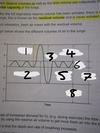M2. U4. RF. Flashcards
Gaseous exchange (83 cards)
adaptations for GE in earthworms.
- whole skin forms GE surface
- diffusion
- thin skin, moist, large surface area
- O2 diffuses into blood
- skin protected by mucus and coelomic fluid
respiratory system is made up of:
air passages, lungs, respiratory muscles
muscles between consecutive ribs
intercostal muscles
8

ribs
adaptations for GE in dicotyledonous plants.
- in leaves
- gas diffuses through stomata in lower epedermis
- surface of spongy mesophyll cells
- large Surface area
- thin walls - moist for absorption of gases
- mesophyl cells have large interior air spaces for transport of gases
- protected inside leaves
small flap that closes the opening to the trachea during swallowing
epiglottis
the compound formed when carbon dioxide combines with haemoglobin when transported
carbaminohemoglobin
the part of the human brain which contains the respiratory Centre
medulla oblongata
vital capacity
total capacity + reserve volumes
structures for gaseous exchange in fish
Gills
single layer of squamous epithelium occurring in the walls of the capillary blood vessels
endothelium
Lungs. internal structure.
- bronchi form bronchioles
- alveoli are thin - layer of squamus epithelium
- surrounded by capillaries
3

exchange of O2 at tissues
7

alveoli
type of epithelium occurring in the walls of the alveoli
squamous epithelium
respiratory muscles
diaphragm. intercostals
7

total lung capacity
medication for the treatment of tuberculosis
antibiotics
4

inhalation reserve volume
Pharynx
- connected to nasal cavity
- leads to glottis and gullet
- mucous membrane
The nasal cavity
- filter air
- lined with mucous membrane that hold ciliated columnar epithelial cells
- lined with capillaries - warms air
- goblet cells - trap dust. antiseptic. moisten air
6

exchange of CO2 at alveoli
2

transport of O2 to tissues



















